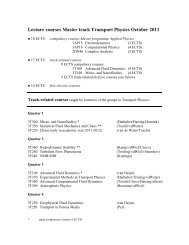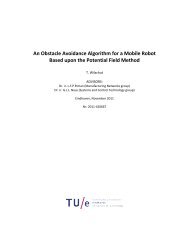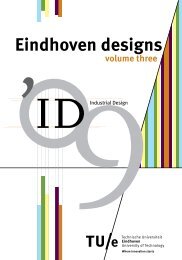Thermo Fluids Engineering Laboratory
Thermo Fluids Engineering Laboratory
Thermo Fluids Engineering Laboratory
Create successful ePaper yourself
Turn your PDF publications into a flip-book with our unique Google optimized e-Paper software.
<strong>Thermo</strong> <strong>Fluids</strong><br />
<strong>Engineering</strong> <strong>Laboratory</strong>
<strong>Thermo</strong> <strong>Fluids</strong><br />
<strong>Engineering</strong> <strong>Laboratory</strong><br />
GENERAL DESCRIPTION OF THE THERMO FLUIDS ENGINEERING LABORATORY<br />
1. Full title of the laboratory <strong>Thermo</strong> <strong>Fluids</strong> <strong>Engineering</strong> (TFE)<br />
2. Group leaders Prof.dr.ir. J.J.H. Brouwers<br />
Prof.dr. L.P.H. de Goey<br />
Prof.dr.ir. A.A. van Steenhoven<br />
3. Short history<br />
The laboratory was created during the successive appointments of Prof. Van Steenhoven (1990),<br />
Prof. Brouwers (1999) and Prof. De Goey (2000). Van Steenhoven, who was in charge of Energy<br />
Technology, started a series of scientific projects on heat transfer and fouling, transitional flows in gas<br />
turbine systems, renewable energy technology and combustion. Brouwers, who before his present<br />
position held a full-time chair at the University of Twente, and here in charge of Process Technology,<br />
initiated the research areas of innovative process design, stochastic turbulence, separation<br />
technology and phase transitional flow, the latter being an extension of existing research on twophase<br />
flow. The combustion part of Energy Technology was split off and combined with the part-time<br />
chair on combustion engines in 2001 after the appointment of De Goey as full professor Combustion<br />
Technology. New areas of research on turbulent combustion and biomass were started. The<br />
laboratory now consists of 3 full-time professors, 5 part-time professors, 4 associate professors,<br />
10 assistant professors, 10 supporting staff members, 3 secretaries, 6 post-docs, 36 PhD students<br />
and 102 MSc students.<br />
4. Research area and mission<br />
The research area of TFE is the field where thermodynamics, (turbulent) fluid dynamics, transport<br />
processes and chemical reactions meet. The primary aim of the program is to generate and apply new<br />
fundamental and experimentally validated knowledge, forming the basis of new developments in the<br />
field of <strong>Thermo</strong> <strong>Fluids</strong> <strong>Engineering</strong>. To that end generic models are developed that can be used in<br />
different fields of application, ensuring optimal flexibility in application. But equally important, our<br />
fundamental insights are used to generate new ideas and concepts, which become incubators of<br />
innovative technology. Our mission is put into practice by the realization and construction of test rigs<br />
and prototypes, which reflect realistic apparatus and processes as found in industry. Established<br />
application areas are: combustion engines, sustainable energy systems and biomass. In each of these<br />
areas a part-time professor has been appointed to create optimal links to industry. Separation<br />
technology has a further strong industry link. Research projects are funded by a variety of sources:<br />
NWO, FOM, STW, EU, SenterNovem, EET, and a growing amount directly by industry.<br />
75% of each group is embedded in the JM Burgerscentrum, the national research school on fluid<br />
dynamics, and 25% of each group belongs to the OnderzoeksSchool Process Technology (OSPT).<br />
The combined contributions of the three groups together give each group a strong position in these<br />
schools, especially in the JM Burgerscentrum. This is reflected in the contribution to three PhD<br />
courses: Combustion, Experimental Methods and Bio-Fluid Mechanics. The laboratory as a whole also<br />
3
actively participates in the two 3TU.Centres of Excellence/Centres of Competence for Fluid and Solid<br />
Mechanics and Sustainable Energy Technologies, respectively.<br />
5. Collaboration within the laboratory<br />
At the moment the laboratory is well balanced with three equally large groups collaborating closely<br />
together. The three sub-programs on Energy Technology, Process Technology and Combustion<br />
Technology together offer good coverage of the scientific field of <strong>Thermo</strong> <strong>Fluids</strong> <strong>Engineering</strong>. Close<br />
collaborations exist between the groups, such as in the area of Sustainable Energy Technologies.<br />
An example is the biomass research area, in which all three groups are active. Two Master’s tracks are<br />
at the heart of the laboratory: the Master’s track <strong>Thermo</strong> <strong>Fluids</strong> <strong>Engineering</strong> (with about 70 MSc<br />
students) and the inter-departmental track Sustainable Energy Technology (with about 20 students),<br />
which was initiated in the laboratory and is now embedded in the 3TU Master’s program on<br />
Sustainable Energy Technology. The lab also contributes to the Master’s tracks on Micro- and Nano-<br />
<strong>Engineering</strong> and Automotive <strong>Engineering</strong> Science within the Master’s program Mechanical<br />
<strong>Engineering</strong> and in the 3TU Master’s program on Fluid and Solid Mechanics.<br />
The most important element that indicates the synergy of the three groups combined in one<br />
laboratory of <strong>Thermo</strong> <strong>Fluids</strong> <strong>Engineering</strong> is the fact that the same basic knowledge is needed in the<br />
three fields, with identical numerical and experimental tools. Scientific tools that are used in the three<br />
groups are numerical methods to solve heat and flow problems such as finite-elements and finitevolume<br />
methods, direct numerical simulation, large-eddy simulation, Monte Carlo methods and<br />
molecular dynamics. Also used in all three groups are experimental techniques to measure velocity,<br />
temperature and concentration fields such as Particle-Image Velocimetry, Laser-Doppler Velocimetry,<br />
Particle Tracking Velocimetry and Laser-Induced Fluorescence, but also conventional techniques such<br />
as hot wires and thermocouples. In addition, much effort is put into the realization of an up-to-date<br />
laboratory, in which the mechanical engineering students (at both MSc and PhD levels) can design<br />
and construct innovative set-ups for analyzing industrial problems and prototyping new designs and<br />
processes with high economic potential.<br />
6. Joint contributions to the educational program of Mechanical <strong>Engineering</strong> students<br />
The <strong>Thermo</strong> <strong>Fluids</strong> <strong>Engineering</strong> <strong>Laboratory</strong> shares a joint responsibility in the Bachelor’s and Master’s<br />
phases for a broad set of courses involving thermodynamics, transport processes and chemical<br />
reactions. The Bachelor’s course in Fluid Mechanics (year 2) is provided by the Applied Physics<br />
department and links up perfectly with the courses provided by TFE.<br />
Bachelor’s program<br />
• Introduction to heat and flow (year 1)<br />
• Installations in process industry (year 1)<br />
• <strong>Engineering</strong> thermodynamics (year 2)<br />
• <strong>Thermo</strong>dynamics (BMT, year 2)<br />
• Heat transfer (year 3)<br />
• <strong>Thermo</strong>-chemical biomass conversion (year 3, elective course)<br />
• Orientation micro- and nano-technology (year 3, elective course, together with CEM)<br />
• Combustion technology (year 3)<br />
Master’s program (elective courses)<br />
• Application of finite element methods to heat and flow problems<br />
• Design of process installations<br />
• Energy conversion<br />
• Energy from biomass<br />
4
<strong>Thermo</strong> <strong>Fluids</strong> <strong>Engineering</strong> <strong>Laboratory</strong><br />
• Fundamentals of the internal combustion engine<br />
• Heat transfer in biological structures (BMT)<br />
• Innovative process design<br />
• Micro-heat transfer<br />
• Modeling of physical phenomena<br />
• Modeling of physical phenomena: stochastic systems<br />
• Modern engine technology<br />
• Fuels and lubricants<br />
• Advanced combustion diagnostics using laser techniques<br />
• Multi-phase flow with heat transfer<br />
• Physical measuring methods<br />
• Renewable energy sources<br />
• Solar cells (together with lecturers from Applied Physics and Chemical <strong>Engineering</strong>)<br />
• Turbomachinery<br />
• Turbulent flow phenomena (together with lecturers from Applied Physics)<br />
7. Joint laboratory<br />
The following laboratories and computer hardware/software infrastructure are in use:<br />
Central laboratory<br />
In the central laboratory the following large-scale test rigs can be found:<br />
• A steam boiler of 1 MW capacity<br />
• A condensation test rig for newly developed industrial heat exchangers<br />
• A turbine-compressor loop for research on compressor system instability<br />
• An expansion tube for subsonic boundary layer transition and heat transfer measurements<br />
• A test facility for the study of small autonomous and grid-connected photovoltaic systems on the<br />
roof of the laboratory<br />
• A test facility for the study of PVT-air combi-panel designs<br />
• A loop for testing new separation designs<br />
• A water loop for testing innovative water-jet pumps<br />
• A prototype of a new small-scale (0.5 MW) steam cycle cogeneration unit<br />
Laser laboratories<br />
For the experimental research use can be made of several specially equipped laboratories.<br />
Experiments are performed in the three laser labs using high-power lasers and sophisticated camera<br />
and data-acquisition systems. The TFE lab possesses 3 continuous Ar-ion lasers (used for flow<br />
visualization and LDV), 4 pulsed Nd:YAG lasers (single-pulse 10 Hz and 30 Hz, and two double-pulse<br />
15 Hz for PIV) and 1 tunable dye-laser (for spectroscopic measurements like LIF). For data recording,<br />
a number of camera’s are available, including a Princeton instruments ICCD-576 camera (for<br />
spectroscopic techniques), an ultra-fast Phantom v7.1 (34.000 fps @ 192x256) camera, a PCO 1200HS<br />
(625 fps @1600x1200) and five Kodak ES-1.0 camera’s (for 2D-PIV/PTV measurements and flow<br />
visualization) and four Kodak ES-2020 camera’s (for 3D-PTV measurements). In combination with<br />
several real-time data-acquisition systems (including a DVCR 5000 high-speed system for 3D-PTV)<br />
and commercial software (Dantec Flowmap, Dantec BSA and PIVtec), non-commercial software (3D-<br />
PTV algorithm developed at ETH, Switzerland) and software developed in-house for post-processing<br />
of the measurement data, it is possible to calculate velocity, temperature, and/or concentration<br />
fields. These facilities are used in the following dedicated test rigs:<br />
• Heat-flux burner set-up for adiabatic burning velocities<br />
• Transfer function set-up for flame-acoustic interaction<br />
• Small scale (ceramic, turbulent low-swirl, Bunsen-type) burner set-ups<br />
5
• Calibration set-up for Mass-Flow Controllers<br />
• Towing tank for flow instabilities behind heated objects<br />
• Micro-PIV set-up for measuring fluid flows in micro-devices<br />
• Benchmark set-up for combined 3D temperature/velocity measurements<br />
• Water channel for boundary layer flows at high-turbulent intensities<br />
• A turbulent pipe flow channel for measuring statistical properties of flows<br />
• A test rig for bubble growth dynamics in boiler tubes<br />
• A set-up for condensing turbulent steam jets<br />
• A test rig for measuring turbulent flow in a mock-up in a hot gas dryer<br />
Combustion laboratory<br />
Small-scale combustion experiments are performed in the fully utilized combustion lab using a series<br />
of workbenches for small-scale experiments. Current set-ups are:<br />
• Flame transfer function set-up for flame-acoustic interaction<br />
• Heat-flux burner systems for measuring adiabatic burning velocities<br />
• Oxy-fuel burner set-up to study heat transfer to quartz<br />
• Small scale (ceramic, turbulent low-swirl, Bunsen-type) burner set-ups<br />
• Calibration set-up for Mass-Flow Controllers<br />
Biomass laboratory<br />
All kinds of experiments are carried out in the biomass lab for the joint research within the TFE lab on<br />
biomass energy conversion. A fixed-bed biomass gasifier with a thermal power of 20 kW is available<br />
to study the details of the processes involved in biomass gasification. The application of a partial<br />
oxidator for tar cracking is another typical example of the processes studied in this lab. Analysis is<br />
performed using a grid reactor and a tube reactor for pyrolysis and an FT-IR set-up for gas analysis.<br />
Engine cells<br />
Several specially equipped engine cells with respect to fuel supply, gas exhaust, noise control etc. are<br />
used for investigations on combustion engines. For example, to study the combustion processes in<br />
(mainly heavy-duty) diesel engines, advanced optically accessible engines and a unique highpressure<br />
cell (EHPC) are positioned in one of these cells. Specially designed test engines can also be<br />
found here to study new combustion concepts (one for HCCI and one optical engine for gaseous fuel<br />
combustion). Experiments are performed in motored and non-motored engines and parts of them,<br />
again using state-of-the-art laser-diagnostic measurement systems but also EU-compliant equipment<br />
for exhaust gas analysis for soot (AVL Smoke meter) and major components, including NOx, UHC, CO<br />
(Horiba).<br />
Climate chamber<br />
For specialized measurements in the area of heat transfer in humans, use can be made of a climate<br />
chamber in which the temperature can be controlled between 15 and 40 °C and the relative humidity<br />
between 10 and 90%. An infrared camera (temperature range from –20 to +350 °C and spectral range<br />
from 7.5 to 13 µm) is available to measure human body temperatures.<br />
Computer hardware<br />
For very large numerical simulations use can be made of national supercomputer facilities in<br />
Amsterdam. For development and testing purposes and for somewhat smaller simulations, a number<br />
of fast computer systems are available. The fastest are: a Linux cluster consisting of 22 dual-dual core<br />
Xeon 5130 processors at 2 GHz in a Infiniband network, a Linux-cluster consisting of 16 dual-CPU<br />
nodes with AMD Opteron 246 processors, one SGI Origin 3800 with 8 R12K processors and two 4-CPU<br />
SGI Origin 200 computers.<br />
6
<strong>Thermo</strong> <strong>Fluids</strong> <strong>Engineering</strong> <strong>Laboratory</strong><br />
Computer software<br />
A large part of the simulation software has been developed in the laboratory, using modern numerical<br />
methods. In some cases, especially for calculations in complex geometries, use is made of software<br />
packages for Computational Fluid Dynamics. The laboratory currently uses SEPRAN, Fluent, ComSol<br />
and Kiva3V for this purpose.<br />
Machine shop<br />
A new workshop has been created within the laboratory, with three technicians, in which new set-ups<br />
and alterations of existing set-ups are realized. The workshop contains one 3D CNC machining center,<br />
seven conventional machining apparatus and one CNC spark-erosion machine. The technicians all<br />
work on a laboratory-wide basis, and have a range of expertise from precision engineering<br />
(construction of strain gages and thermocouples) to construction of high-temperature (biomass<br />
gasifier), high-pressure (combustion cell) set-ups and full-scale process equipment.<br />
TFE also has a joint laboratory staff. In principle all of the 9 tenured laboratory staff members in the<br />
laboratory belong to one group (each professor has 3 staff members), but the work in the different<br />
disciplines of the laboratory is divided without boundaries between the separate groups. Together, all<br />
the required disciplines and levels of assistance are available in the lab. We also have a joint<br />
secretariat with 3 part-time secretaries, working closely together.<br />
8. Joint activities<br />
Each week a joint TFE seminar is organized and an informal joint meeting of all members is held, at<br />
which relevant information regarding TFE is shared. Social events within the laboratory are also<br />
encouraged to strengthen the team spirit. A joint coffee break for all members of the laboratory is<br />
held weekly in the TFE social area “de Vuurplaats”. Parties are regularly organized in the laboratory to<br />
celebrate special events, mostly by the TFE student organization “dQ”. The group has its own soccer<br />
team ‘Vlammen Maar’, playing in the TU/e soccer league. The TFE Christmas “Cabaret Party” has<br />
been a well-known event for a number of years, at which TFE members, students, alumni and retired<br />
personnel meet.<br />
7

















